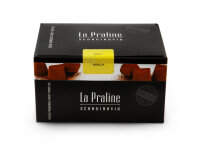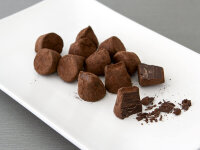
Matcha Tea
Another quality criterion is the color of the powder. Vibrant, intense hues are a good sign of high-quality matcha tea. A yellow-brownish color is an indication of lower quality or decreasing freshness, which can result from mishandling the matcha. Green tea is very light-sensitive when it comes to storage and should be kept in the dark. Contact with oxygen from the air can cause green tea to lose its aroma more quickly. Quality levels within high-quality matcha vary finely, from ceremonial grade to premium quality to culinary grade. However, this mainly pertains to taste, as the ingredients and effects of matcha tea have very minor differences. Of course, there are also lower-quality green tea powders that may include stem parts, but such variations are not offered by ORYOKI.
Matcha Tea in Relation to Your Health
Since the powder is dissolved in water, matcha tea contains all the health-promoting ingredients found in the whole leaf. These include high concentrations of cell-protecting antioxidants/catechins (EGCG), amino acids, especially L-Theanine, which promotes well-being, balance, and relaxation, caffeine, and various vitamins (Vitamin A Beta Carotene, Vitamin B1, B2, B3, Vitamin E, and Vitamin K). These components are responsible for the exceptional effects of matcha and are the chemical explanation for why matcha tea has a reputation for being particularly healthy.
It's worth mentioning the very high ORAC value of good-quality matcha. ORAC stands for Oxygen Radical Absorption Capacity. It's a measurement method from the USA that, simplistically put, determines the antioxidant ability of natural substances.
Organic-Quality Matcha at ORYOKI
Another important quality criterion is the color of the powder. Vibrant, intense hues are a good sign of high-quality matcha tea. A yellow-brownish color is an indication of lower quality or decreasing freshness, which can result from mishandling the matcha. Green tea is very light-sensitive when it comes to storage and should be kept in the dark. Contact with oxygen from the air can cause green tea to lose its aroma more quickly. Quality levels within high-quality matcha teas vary finely: from ceremonial-grade quality to premium quality for culinary use. However, this mainly pertains to taste, as the ingredients and effects of matcha tea have very minor differences. Of course, there are also lower-quality green tea powders that may include stem parts, but such variations are not offered by ORYOKI.
Here are some matcha teas from our assortment:
- Organic Matcha Shinayaka, Ceremonial Grade, Super Premium »
- Organic Matcha Hananokaori, Ceremonial Grade, Super Premium »
- Organic Matcha Jikaku, Ceremonial Grade, Super Premium »
- Organic Matcha Mainichi, Premium Grade »
The Right Preparation of Matcha Tea
For the full enjoyment of matcha, the following procedure has proven successful. The usual, thin matcha (Usucha) is prepared as follows: Put 2 - 3 bamboo scoops (Chashaku in Japanese) of powder into a matcha bowl, preferably through a small sieve. Then add about 5 - 6 ml of 80°C warm water and whisk the green tea powder with a bamboo whisk (Chasen) until smooth, dissolving even the tiniest lumps. Afterward, add another 80 - 100 ml of 75 - 80°C warm water and vigorously whisk the matcha tea with a loose wrist movement until it becomes frothy. Move the whisk only back and forth, spreading it evenly over the entire surface.
Rinse the matcha whisk with clear cold water after enjoying the tea and let it dry.
The somewhat thicker Koicha matcha is exclusively prepared with the highest quality grades. Here too, the matcha powder is sifted beforehand. The difference compared to Usucha is the concentration. Use 4 bamboo scoops of powder in the bowl and pour about 50 - 70 ml of 80°C warm water. Then, similarly to the method described above, whisk it until frothy.
You can find instructions on how to prepare a delicious matcha latte in our magazine article: Matcha Latte - a Delicious Recipe
When and How Much Matcha Should You Drink Maximum Per Day?
Due to its positive properties, enjoying matcha tea throughout the day is a soothing and healthy alternative to other hot and cold beverages. However, those who have discovered matcha and want to incorporate it into their diet on a regular basis should not underestimate the effects of this "superfood." We recommend enjoying matcha in moderation, which means a maximum of two bowls per day. The powder is the product of ground green tea leaves and has the highest caffeine content among teas. Due to its invigorating ingredients, matcha is a real energy booster and is best consumed in the morning or before noon.
Since the tea's caffeine is bound to secondary plant compounds and is released in the intestines, the effect is somewhat delayed. Compared to coffee, which has a rapid and strong effect, matcha's invigorating effect lasts over a longer period.



Matcha is a Trend in the West
Currently, powdered tea is enjoying popularity outside of the Japanese tea ceremony. This is due, among other things, to the intense green color that can give food a fascinating appearance. Many are familiar with it from the trendy drink "Matcha Latte To Go" and other matcha beverages. Matcha ice cream provides a delicious refreshment in the summer. The fine powder can be used to create many other exciting food creations. Recipes for these can be easily found on the internet.
What Does Matcha Tea Taste Like?
Matcha, like all other foods, is a matter of taste. The characteristic umami taste resembles a distinctive, sweet, slightly fruity, and sometimes nutty flavor. A crucial factor that determines the matcha's taste is the right dosage and the method of preparation. Depending on the intensity or preparation method, the taste can vary from sweet and mildly creamy to highly aromatic and full-bodied. The quality of the tea powder is equally critical to the taste experience. It is determined by the variety, origin, and processing of the tea leaves. Our ORYOKI matchas come from organic-certified tea farms and are classified as Ceremonial Grade, the highest quality category. Only the finest, young leaves of the Sencha plant are ground into powder to guarantee a distinctive taste.
A rough rule of thumb is: the cheaper the matcha, the more robust and bitter the flavor may be. A sustainable and gentle production process is reflected in the tea's quality, justifying its higher price status. Tea newcomers typically prefer a fine, mild matcha with a fruity, floral note. Since there are countless matcha varieties, and individual tastes vary, a bit of experimentation is needed to find the "most delicious matcha" for oneself. In general, beginners are advised to start with the mid-range in terms of price and flavor and explore their preferences later on.
Which Matcha is the Best?
This question cannot be answered universally. Personal preferences play a crucial role when evaluating matcha. Especially experienced tea drinkers know their preferences and know which variety tastes best to them with a particular preparation method. Each variety has its own character.
While the milder and more expensive varieties are often used in matcha beverages, the more intense and cost-effective powders are increasingly used in cooking. Both the health aspects of the ingredients and the intense green color complement every creation perfectly. In recipes with dominant ingredients like flour, sugar, and cream, the fine taste of premium matcha teas often gets lost. Therefore, for cooking and baking, it is recommended to use more affordable products. These generally have a more robust and dominant flavor, making them stand out better in dishes. The choice of the best matcha depends on its suitability for the desired preparation method, personal taste preferences, and budget.
Can You Prepare Matcha with Cold Water?
Matcha powder is well-suited as a base for a refreshing drink on hot summer days. The powder can also be mixed with water at a lower brewing temperature. Compared to the traditional method of mixing with hot water, this results in slightly less foam. The vitamins contained in matcha remain completely intact, and the flavor becomes even more pronounced at a cooler drinking temperature.





